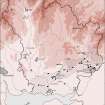Harelawhill
Lime Kiln(S) (18th Century), Lime Works (18th Century), Limestone Quarry (18th Century)
Site Name Harelawhill
Classification Lime Kiln(S) (18th Century), Lime Works (18th Century), Limestone Quarry (18th Century)
Alternative Name(s) Harelaw Lime Works; Harelawhill Quarries; Harelawhill Mines; Rowanburn; Harelaw Limekilns
Canmore ID 67840
Site Number NY47NW 16
NGR NY 42689 78816
NGR Description Centred NY 42689 78816
Datum OSGB36 - NGR
Permalink http://canmore.org.uk/site/67840
- Council Dumfries And Galloway
- Parish Canonbie
- Former Region Dumfries And Galloway
- Former District Annandale And Eskdale
- Former County Dumfries-shire
Field Visit (29 April 1993)
NY47NW 16 centred 4271 7880
The limestone quarry at Harelawhill, together with the coal mines at Archerbeck (NY47NW 22), were leased in the early 1770's by the Duke of Buccleuch to an Englishman called Lomax. The limestone at Harelawhill was renowned for its purity, and continued to be quarried throughout the 19th century, with operations being transferred from SW of the road to the NE by 1850. The 1st edition of the OS 6-inch map shows the extent of the quarrying operations in the 1850's, with the earliest workings on the SW depicted as a long, narrow trench. This can still be seen, driven from the N, together with its spoil dump immediately to the E. Also shown on the map is the tramway which brought the limestone from the NE workings across the road to the kilns. By the end of the 19th century, however, the lime works had fallen out of use, being noted as disused on the 2nd edition of the OS 6-inch map surveyed in 1898 (Dumfriesshire, sheet liv, 1862 and 1900 respectively).
At the behest of the Buccleuch estate, the quarry was reopened on two occasions this century, the first from 1934 to 1938 by Mr Potts of Prioryhill, Rowanburn. On this occasion the limestone was quarried on the NE side of the road, opposite the two kilns, and the coke used to burn the lime was supplied by the Carlisle Gas Works. In 1947, operations returned to Harelawhill to mine the limestone and, by a combination of steam drill and blasting, five parallel drifts were driven into the rock. These five drifts run for a distance of about 110m, dipping with the strata, before the westernmost two curve round and head S for some 450m. The drifts are all interconnected, the remaining blocks of limestone having been left to support the roof; this method of mining, known as room-and-pillar, is more commonly associated with coal extraction.
Traces of the tramway system are still visible within the mine, some of the sleepers surviving in situ, and fragments of the steel ropes used to pull the hutches can still be found. The hutches were pulled up through an opening located towards the entrance of the westernmost drift, and on to a loading platform where the limestone was sorted. Two brick-built structures survive on this platform and are probably associated with the sorting process.
Although much of the limestone was crushed for road construction, the blasting method of opening the mine generated considerable quantities of small stone, and a ground limestone operation was introduced. To this end, the kilns were re-opened and enlarged. The kiln bank with its two bowls can still be seen, supported by buttresses, although the detail of the three draw arches has been obscured by the construction of a silage pit, and in one case the opening has been infilled with breeze block. By 1966, however, the limestone became too difficult, dangerous and expensive to mine and the site was abandoned. A plantation now extends across most of the site, but access to the drift mines can be obtained from the quarry face.
Visited by RCAHMS (ARW, SPH), 29 April 1993.
Stat Acct 1791-5; NSA 1845; T Robertson, J B Simpson and J G C Anderson 1949.
Harelawhill. Listed as quarries, mines and kilns.
RCAHMS 1997.
































